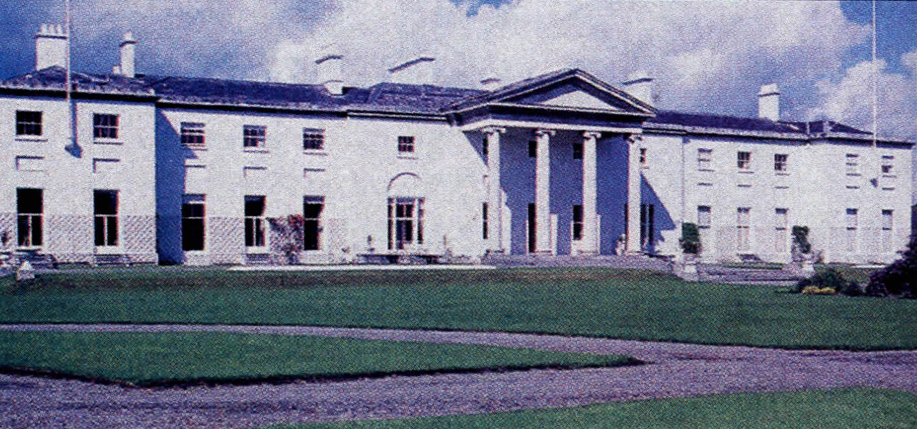The hottest ticket in Dublin is no longer to the Abbey Theatre. It’s a ticket to tour Áras an Uachtaráin, the sprawling white-pillared residence of the President of Ireland in Phoenix Park. Best of all, tickets are free, but available only on Saturdays on a first-come basis at the Phoenix Park Visitor Centre.
Hearing the news as I arrived in Ireland last month, I decided it was well worth joining in the Saturday morning line (known to Dubliners as “The Queue”).
Tours officially start at 9:45 a.m., so I was there shortly after 9 a.m.
To my surprise, I was the first one on line. Slowly, I was joined by about 20 others, mostly Irish people eager to see the inside of their President’s house.
Like clockwork at 9:45, Deirdre (our guide from Lifford, Co. Donegal) appeared and led our “early bird” group into the Phoenix Park Visitor Centre, the start of our tour. Deirdre is one of a core of guides from all parts of Ireland who work for the Office of Public Works, the government agency that maintains this eminent house.
Tickets were handed to each of us as we entered. The tour starts with an introductory audio-visual that gives background on the history and architecture of the house, dating back to 1751. The house, first known as Phoenix Park Lodge, was originally a private hunting lodge, then for 140 years (1782-1921) was the residence of British viceroys, followed by 16 years of British Governors General, and finally in 1938 it became the home of Ireland’s presidents. Eight presidents have lived here including the incumbent Mary McAleese.
At first glance, Áras an Uachtaráin looks remarkably like the White House in Washington, and this is no coincidence. James Hoban, the Irish-born architect of the White House, is said to have used the portico of the original Phoenix Park Lodge as a model for the façade of the White House, and then he patterned the interior on the first and second floors of Dublin’s Leinster House.
After the 10-minute A/V, everyone boards a bus for the 3-minute ride to the Áras. The tour starts in the basement with a walk-around tour of a mini-museum that displays a series of exhibits on the house’s former and current occupants. As I looked over the names of the early viceroys, I quickly learned where many of Dublin’s current street names originated — Arthur Capel (Capel Street), James Harcourt (Harcourt Street), Charles Talbot (Talbot Street), William Fitzwilliam (Fitzwilliam Street), Philip Yorke (Yorke Street), and Henry Herbert (Herbert Street). The museum is also a one-stop source for mastering all the names of Ireland’s presidents — Hyde, O’Ceallaigh, deValera, Childers, O’Dalaigh, Hillery, Robinson, and McAleese.
Then it’s a short walk upstairs to the ground floor and a guided tour through seven rooms including the newest section of the house, the State Corridor (1957), a long hallway decorated with two huge Waterford Crystal chandeliers and stucco wall panels, providing a classic backdrop for a display of bronze busts of all Ireland’s Presidents on Connemara marble pedestals. Foreign diplomats present their credentials amid this awesome setting!
The State Dining Room (1849), with its huge table of Georgian mahogany, is the most historically significant room — it was the setting for the first-ever Irish cabinet meeting.
Next is the State Reception Room (1802), where the President greets guests.
Special features of this room are a handwoven Donegal carpet from Killybegs, and an 18th century Dublin Neoclassical marble fireplace.
The Council of State Room, dating back to 1751 and part of the original house, was originally a billiards or pool room. Today it is very artistic — the walls are lined with portraits of the Presidents and the ceiling depicts Aesop’s Fables in a unique pattern of gilded Rococo stucco work.
Presidential entertaining is done in The State Drawing Room (1751), with glass doors that open onto the gardens outside and a huge piano. “Yes, it’s always kept in tune,” says our guide Deirdre. To stimulate good conversations, the walls are lined with rare paintings on loan from the National Gallery, and the décor has a rich collection of 18th-and 19th-century giltwood furniture.
“The gilded sofa was a favorite of President deValera,” Deirdre advises. “You can just picture him right there in front of the fireplace.”
My favorite room is the President’s Study (1751), with a wrap-around 19th century bookcase, chock full of governmental volumes. The wallpaper is hand-painted, originally from Birr Castle in Co. Offaly.
“The President cleans away all the papers from her desk each Saturday morning for these tours,” Deirdre smiles. On the desk are freshly picked roses from the garden, a Waterford Crystal clock, and McAleese family photos including one picture of the President as a young girl.
Using typical Irish logic, the tour ends at the Main Entrance Hall. It is a part of the original house, with many features dating back to 1751 including a magnificent coffered barrel-vaulted ceiling and an 18th-century wine cooler that once belonged to Irish liberator and early Lord Mayor of Dublin, Daniel O’Connell. The Irish national coat of arms — a harp on a blue background — hangs above the door.
Just as our tour ended, we got a bonus — a glimpse of President Mary McAleese as she was entering the house. ♦


Leave a Reply